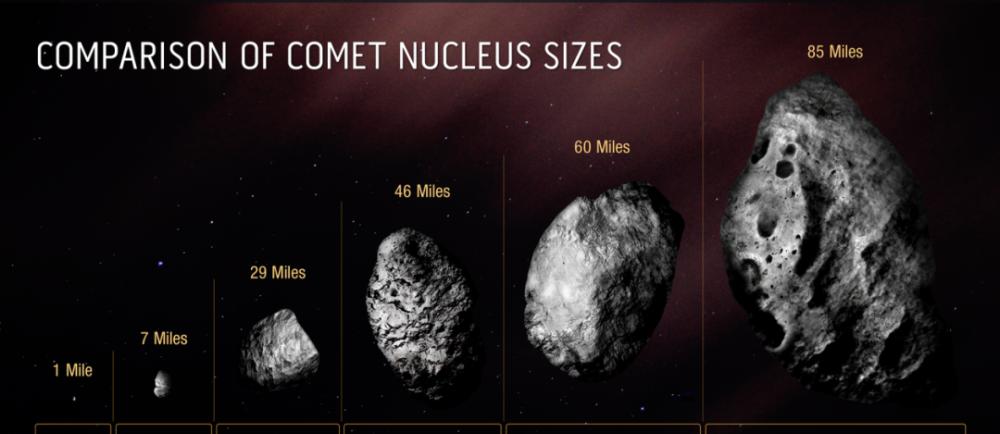Recently, the Hubble Space Telescope discovered the largest comet ever recorded, and its comet nucleus (the solid part of the comet) is about 80 miles in diameter and weighs 500 trillion tons, which is 100,000 times that of a typical comet.

Figure | C/2014 UN271 compared to the size of other comets (Source: NASA)
It is understood that comets are a type of small object that orbits the sun. Most known comets are smaller than Halley's comets as we know them, typically 1 mile in diameter or less.
Previously, the largest comet was C/2002 VQ94, or Hale-Bopp, which is about 60 miles in diameter. The comet that broke its record this time is called C/2014 UN271.
Currently, the behemoth is approaching the sun at 22,000 mph, but don't worry about it eventually crashing into Earth. Its perihelion is about 1 billion miles from the Sun, which is greater than the distance from Saturn to the Sun. It will not reach this closest distance until 2031.
In addition, one of the reasons why it is possible to measure the size of a comet at such a distance is because water ice is constantly lost as it approaches the Sun. Astronomers also point out that since C/2014 UN271 is approaching the Sun, the material on it is constantly "evaporating" (the formation of the comet tail), once the return journey begins, it will most likely be only half its current size.
At this point, the comet's orbital period is about 3 million years, and after leaving the country, the period becomes about 4.5 million years due to the reduction of mass.
C/2014 UN271 was observed by astronomers Pedro Bernardinelli and Gary Bernstein during a dark energy survey at the Cerro Tololo Observatory in Chile during a dark energy survey of the solar system's celestial bodies. At the time, C/2014 UN271 was 3 billion miles from the Sun, roughly comparable to Neptune's position. And now the comet is less than 2 billion miles from the sun,
In addition, because comets are generally named after their discoverers, the comet is also called Comet Bernardinelli-Bernstein.
Ground-based and space telescopes have been conducting in-depth research on C/2014 UN271 since it was first discovered. Recently, researchers published a paper in The Astrophysical Journal Letters titled "Hubble Space Telescope Detection of the Nucleus of Comet C/2014 UN271," describing their specific discovery process.
(Source: NASA)
The sequence picture above shows the separation of the comet nuclei of C/2014 UN271 from dust gas. According to NASA's official website, "the picture on the left is a photo of a comet taken by the Hubble Space Telescope's wide-field camera on January 8, 2022." Combined with data from radio telescopes, astronomers achieved precise measurements of the size of the comet nucleus of C/2014 UN271. ”
David Jewitt, a professor of planetary sciences and astronomy at UCLA and one of the study's co-authors, said: "This comet is actually the tip of the iceberg of thousands of comets, others too faint to be observed. We've always suspected that 2014 UN271 is huge because it's still bright at such a distance. But we need the best data to confirm that. ”
Although the 2014 UN271 is large enough, it is too far away to observe it. One of the difficulties in measuring the comet is the need to distinguish its nucleus from the coma that envelops it.
"Although Hubble was unable to resolve it visually directly, according to the telescope's data, there is a bright peak of light at the location of the comet nucleus." The paper's lead author, Man-To Hui of Macau University of Science and Technology, said. He and his team then used the Hubble telescope's photographs of the comet to make a computer model that eliminated the effects of the coma so that the comet nucleus could be better measured.
(Source: NASA)
Regarding the source of C/2014 UN271, it is understood that it originated from the Oort Cloud (a hypothetical "spherical cloud" that surrounds the solar system) with trillions of comets.
The concept of the Oort cloud was first proposed by the Dutch astronomer Jan Oort in 1950. It has an inner edge of 2,000 to 5,000 astronomical units (the distance between the Sun and the Earth). The outer edge radius may be about 1 light-year.
It is worth noting that the Oort cloud is still a theoretical concept, and the comet in it is too weak to observe directly, and its specific structure is almost invisible. However, according to the analysis of the evolutionary model of the solar system, it can be largely confirmed that the Oort cloud is real. In addition, comets come from different directions, which indicates that their shape is spherical.
It is reported that the comets in the Ault Cloud are considered by most scientists to be remnants of the formation of celestial bodies such as the Sun and the Earth. Billions of years ago, they were thrown out of the solar system by the enormous gravitational pull between Jupiter and Saturn. These comets re-enter the solar system only when they are gravitated by the gravitational attraction of passing stars.
Finally, the discovery of C/2014 UN271 provides some clues to the study of the Ault Cloud. We may be able to further understand the total mass of the comets among them and their distribution. Currently, it is estimated that the mass of the Ault Cloud may be 20 times that of Earth.
In the future, through indirect observations of "passing" comets and increasingly deep-space surveys, we may gradually reveal the true face of the Oort Cloud and its role in the evolution of the solar system.
It is worth mentioning that it is estimated that in 300 years, NASA's Voyager probe will be able to reach the inner region of the Oort Cloud, but it may take 30,000 years to pass through.
-End-
reference:
1.M. Hui, D. Jewitt, L. Yu,M. Mutchler.Hubble Space Telescope Detection of the Nucleus of Comet C/2014 UN271. The Astrophysical Journal Letters929(2022).https://iopscience.iop.org/article/10.3847/2041-8213/ac626a
https://www.nasa.gov/feature/goddard/2022/hubble-confirms-largest-comet-nucleus-ever-seen